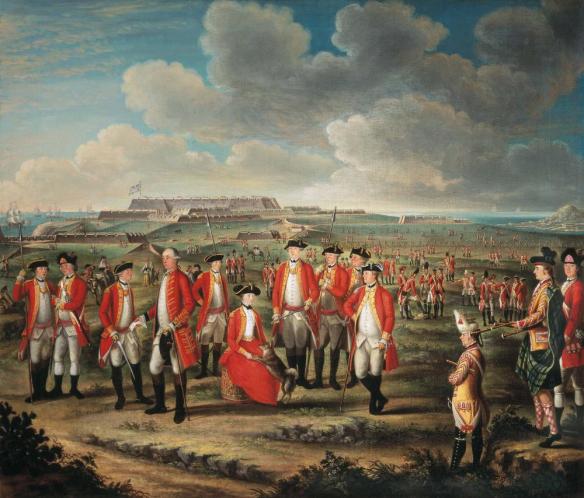25th Regiment of Foot. A lengthy period of service in Minorca (1768-80) was followed in 1782 by an expedition to Gibraltar, which was under attack by Spain. In the same year the Regiment was retitled ‘The 25th (Sussex) Regiment of Foot’. It was thought that the addition of an English county name would stimulate recruiting! ‘Lady Louisa Lennox with her husband’s Regiment, 25th Regiment of Foot’ with Lord Lennox beside her, and Fort St Philip, Port Mahon, in the background, c1771. Oil on canvas, one of a set of six unsigned oil paintings on canvas attributed to Giuseppe Ignacio Maria Chiesa (1720-89), c1769-71
Invaded by Britain’s Royal Navy in 1708 during the War of the Spanish Succession, Minorca temporarily became a British possession. Britain took possession in 1713 under the terms of the Article XI of the Treaty of Utrecht. Under the governorship of General Richard Kane, this period saw the island’s capital moved to Port Mahon, and a naval base established in that town’s harbour.
During the Seven Years’ War, France captured the island after the Siege of Fort St Philip (1756), following a failed British relief attempt. Thanks to the Treaty of Paris (1763), the British returned to the island again following Britain’s victory in the Seven Years’ War. During the American War of Independence, the British were defeated for a second time, in this instance by a combination of French and Spanish forces, which regained the island after a long siege of St. Philip’s Castle in Port Mahon on 5 February 1782. The British ceded the island back to Spain the next year in the Treaty of Versailles. Minorca was invaded by the British once again in 1798, during the French Revolutionary Wars, but it was finally and permanently repossessed by Spain by the terms of the Treaty of Amiens in 1802. The British influence can still be seen in local architecture with elements such as sash windows.
#
As the rest of the Balearic Islands, Minorca was not occupied by the French during the Peninsular War, as it was successfully protected by the Royal Navy, this time allied to Spain.
The French invasion of Minorca in April 1756 was the event that finally sparked a formal declaration of war between France and Great Britain. The Royal Navy had a major base at Port Mahon on Minorca and another at Gibraltar, and they were under orders to intercept any French movement in the Mediterranean and to observe French preparations in the port of Toulon. There had been reports that the French were preparing an invasion fleet against Great Britain from various bases, and Admiral John Byng was sent to the region with an additional 10 ships of the line to protect the two naval bases. The Royal Navy had already deployed many ships of the line to protect commerce between the West Indies and North America, as well as to intercept any French shipping either dealing in commerce or reinforcement of overseas garrisons. The British had 2,500 troops on the island of Minorca, while the French, under the command of Admiral Count Augustin de la Gallissonniere, had assembled an invasion force of 12 ships of the line and 15,000 soldiers.
The French had landed and invested Port Mahon by the middle part of April. By 8 May they had opened fire on the defenders of Port Mahon, the same day that British reinforcements left Gibraltar. When news of the French invasion reached London, Great Britain acted, formally declaring war on France on 17 May 1756. The naval battle of Minorca occurred on 20 May; Byng’s squadron by this time numbered 13 ships of the line. The British had five ships heavily damaged, and the French pulled away and blockaded Port Mahon. Byng felt that the reinforcements he had on board were not sufficient to lift the siege of Port Mahon, and he returned to Gibraltar, forcing the garrison on Minorca to surrender on 28 May. Admiral Byng was later tried by court martial, convicted of not doing his utmost, and shot.
